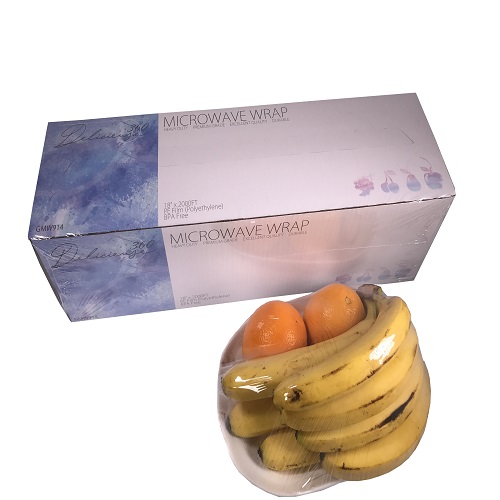We are committed to food packaging PVC cling film, PE cling film,stretch wrap, aluminum foil and other disposal food packing film/foil.

Language
>Microwave wrap is a specialized food packaging material designed for microwave cooking and reheating applications. These wraps are engineered with advanced polymer formulations that can withstand microwave radiation while maintaining food quality. Modern microwave wraps typically consist of multilayer structures combining polyethylene terephthalate (PET) for heat resistance (withstanding temperatures up to 220°C/428°F), polypropylene (PP) layers for moisture control (with water vapor transmission rates below 5g/m²/24h), and sometimes aluminum coatings for controlled heating patterns. The material thickness generally ranges between 40-100 microns, providing optimal balance between durability and microwave transparency.

Dielectric Properties: Engineered with a dielectric constant (ε') between 2.2-2.5 and loss factor (ε") of 0.001-0.005 for efficient microwave energy transfer
Heat Resistance: Can maintain structural integrity at temperatures up to 220°C (428°F) for short durations
Barrier Properties: Oxygen transmission rates below 50cm³/m²/24h and moisture vapor transmission under 5g/m²/24h
Safety Compliance: Meets FDA 21 CFR 177.1520 standards for food contact materials
Thermal Conductivity: Ranges between 0.15-0.25 W/m·K for even heat distribution
In commercial kitchens, microwave wraps with high-density polyethylene (HDPE) layers (typically 60-80 microns thick) are used for batch cooking. These wraps can handle steam pressures up to 0.5 bar without rupturing, making them ideal for sous-vide microwave combinations. The food service sector particularly values wraps with anti-fog coatings that maintain visibility during cooking (haze values below 15% according to ASTM D1003).
Pre-packaged meals employ microwave wraps with precisely engineered susceptor technology - thin (10-30 nm) metallic layers that create localized heating zones reaching 180-200°C (356-392°F) for browning effects. These packages often incorporate ventilation technologies that open at specific temperatures (typically 95-105°C/203-221°F) to release steam while maintaining package integrity.
Sterilization wraps for medical instruments utilize spunbond-meltblown-spunbond (SMS) polypropylene constructions with basis weights of 50-100 g/m². These materials maintain >99.9% bacterial filtration efficiency while allowing steam penetration during autoclaving. The wraps demonstrate >90% strength retention after 5 sterilization cycles according to EN 868 standards.
In material science applications, high-performance microwave wraps with ceramic-loaded polymer matrices (containing 15-30% aluminum oxide by weight) are used for curing composite materials. These wraps can sustain continuous exposure to 2.45 GHz radiation at 800-1000W for durations exceeding 30 minutes without degradation.
Reusable microwave wraps should be cleaned with pH-neutral detergents (6.5-7.5 pH) at temperatures below 60°C (140°F). Abrasive cleaners exceeding 1000 grit can damage surface treatments. For medical-grade wraps, follow ANSI/AAMI ST79:2017 guidelines for sterilization wrapper maintenance.
Store microwave wraps in environments with 40-60% relative humidity and temperatures between 15-25°C (59-77°F). Avoid UV exposure as it can degrade polymer chains, reducing tensile strength by up to 40% after 200 hours of sunlight exposure (per ASTM D4329).
Regularly test wrap integrity through water vapor transmission rate (WVTR) measurements (ASTM E96) and seal strength tests (ASTM F88). Replace wraps showing >15% reduction in original performance metrics. For medical wraps, conduct bacterial filtration efficiency tests after each sterilization cycle.
Most microwave wraps are #5 PP recyclable, though multilayer constructions may require specialized processing. Energy recovery through incineration is viable for clean wraps, with heat values of 40-46 MJ/kg. Always follow local regulations for disposal of food-contaminated or medical wraps.